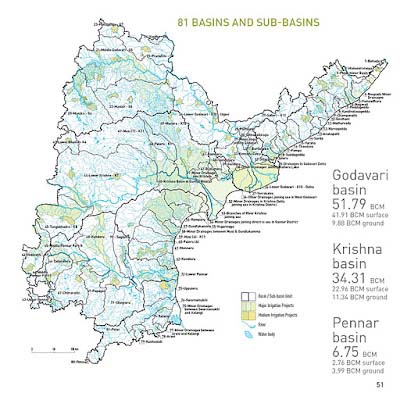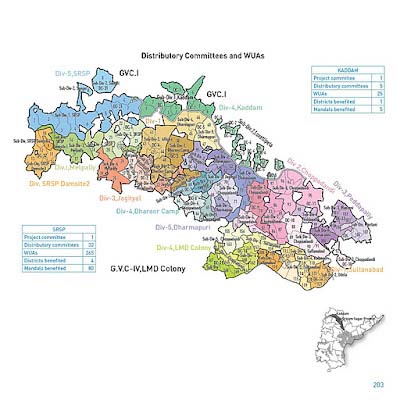This atlas on water resources in Andhra Pradesh by International Water Management Institute (IWMI), IWMI-Tata Water Policy Program (ITP), Visual Information Systems for Action (VIStA) and Government of Andhra Pradesh (GoAP) is an attempt to analyse the existing data from the public domain of several government organisations and present the data through visually appealing maps and other visually attractive forms to show the spatial and temporal distribution of the water available and the way it is used, to act as a quick guide and a decision-support system.
The atlas has relied wholly on publicly available data from various state and central government organisations. Considering the normal time lag for the latest information to be available, the data for the year 2007-08 has been taken as a common denominator, as far as possible, for the present atlas. One of the key themes running across the atlas is the dynamics of spatial and temporal trends, and wherever possible indicating areas where water usage can be enhanced, for water is a precious resource and spells life.
The chapters are arranged in a sequence for ease of navigation and grouped in four parts.
Part I highlights the country-level status and thereby the status of Andhra Pradesh compared to other states in India. The themes covered in Chapter 1 are physiography, climate, irrigation characteristics, cropping pattern, population and land. This chapter also provides a multivariate analysis of irrigation sources and the level of irrigation to create an irrigation profile of the districts in India.
Part II deals with water per se. Chapter 2, the opening chapter of this part, deals with the climate of Andhra Pradesh highlighting the rainfall distribution and the latest trends in its seasonality. One immediately visible pattern is the shift in peak rainfall period from July to August.
Chapter 3 deals with the physiography and land-use characteristics of Andhra Pradesh. The land-use characteristics are derived from remotely sensed images and interpreted by Andhra Pradesh State Remote Sensing Application Centre (APSRAC). The original classification by APSRAC categorises land use in 66 classes. For the convenience of understanding the categories have been regrouped to the present 11 classes to highlight the major types of land use generally desired by planners and academics.

Basins and sub-basins of Andhra Pradesh
Chapter 4 provides sub-basin wide availability of water and the sub-basin map with drainage pattern. All the 81 sub-basins are covered and presented with the ground and surface water quantity through a table. The analysis of per hectare water availability across the basins provides a deeper understanding of the socio-economic status of the region. We are showing two maps that measure the risks associated with the overexploitation of ground water. The initial calculation is done by the Department of Ground Water at the assessment unit (micro-basin) for compatibility with hydro-geological units, and converted at mandal level for easy correlation with the basic administrative unit. The Department of Ground Water and the Chief Engineer, Hydrology, regularly assess the water quality of the ground water and surface water of irrigation projects respectively. Geographical spread of the poor water-quality areas is also included to highlight health and other risks.

Distributary Committees and WUAs in SRSP above Manair
Chapter 5 deals with Floods and Droughts. Mapping and listing the tanks that affect the railway tracks is a unique feature of this chapter. Maps of areas prone to drought (based on moisture stress) is derived from the Government of India’s notification of drought-prone blocks.
Part III covers water usage. Irrigation dominates this segment as about 93 per cent of the total water is used for irrigation. The remaining is used for drinking and domestic purposes and industries.
Chapter 6 on Irrigated Areas highlights that irrigation by surface and ground water are equally important. Irrigation via tanks has been declining continuously for about five decades. Groundwater usage exceeding the annual dynamic recharge in certain areas, particularly non-command areas, has reached non-sustainability with likely adverse impact on the livelihood of dependent farmers. The demand from the hydropower sector is also putting pressure on the water allocated for irrigation during the water-deficit years.
Chapter 7 on Irrigated Agriculture deals with the major crops raised under surface and ground water in the kharif and rabi seasons in Andhra Pradesh. Paddy still dominates irrigated agriculture but the percentage of area covered under paddy is giving way to maize and cotton. At the micro level the area under fruit and vegetable is gradually increasing. The chapter also presents the synthesis of types of irrigation with crops raised to highlight the symbiotic relationship with each other.
Chapter 8 on Water and Livelihood presents the natural availability of water per hectare and the coverage through irrigation as resource endowment. The population density and occupation are the response to the availability of water, naturally or artificially. The result is the ownership of assets and expenditure on education. The chapter also presents three typologies. First one shows the evolution of literacy rate, sex ratio in education and the level of drop-outs in schools. The second shows the relationship between availability of water with poverty, social deprivation, and low literacy. The third one proposes to derive the trends and risks from water use and its sustainability.
Part IV of the atlas looks to the future of water and puts forward suggestions for ways to conserve this resource and use it with greater efficiency. It has 13 chapters highlighting water management in the major irrigation projects in Andhra Pradesh.
- Chapter 9—Farmer-Centric Water Management
- Major irrigation projects: Chapter 10 —Nizamsagar Project
- Major irrigation projects: Chapter 11 —Sri Ram Sagar (SRSP) & Kaddam Projects
- Major irrigation projects: Chapter 12 —Godavari Delta System (GDS)
- Major irrigation projects: Chapter 13—Northeast Coastal Projects: Yeleru, Vamsadhara, Nagavali, Narayanapuram & Thandava
- Major irrigation projects: Chapter 14— Tungabhadra Project Low Level Canal (TBP LLC) & Chapter 15—Jurala & Rajoli Banda Diversion Scheme (RDS)
- Major irrigation projects: Chapter 16— Nagarjuna Sagar Left Canal (NSLC) & Musi Projects & Chapter 17—Nagarjuna Sagar Right Canal (NSRC) Project
- Major irrigation projects: Chapter 18— Krishna Delta System Project (KDS) & Chapter 19— Tungabhadra Project High Level Canal (TBP HLC)
- Major irrigation projects: Chapter 20— Kurnool-Cuddapah Canal (KCC) and Srisailem Right Bank Canal (SRBC) Projects & Chapter 21— Somasila & Pennar Delta Projects
Please view the entire atlas here